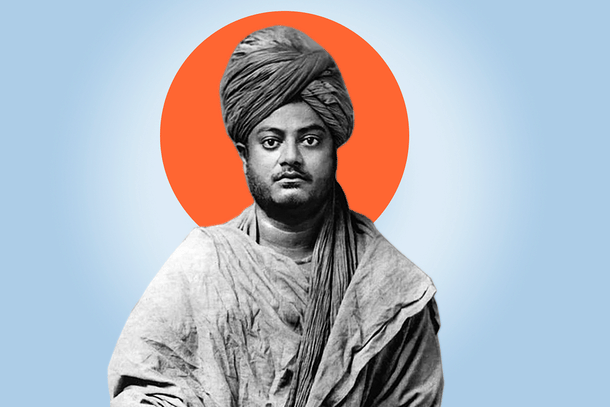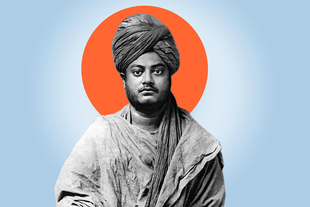Commentary
Three Nights, A Dawn And Swami Vivekananda
Aravindan Neelakandan
Jan 12, 2023, 01:20 PM | Updated 01:20 PM IST
Save & read from anywhere!
Bookmark stories for easy access on any device or the Swarajya app.


1892 Kanyakumari
India of the ancient Rishis, was under the strangling grip of colonialism. Its ancient way of life was collapsing. Poverty and misery, arising out of self-apathy and colonialism, permeated the entire nation. Inhuman treatment of fellow humans became accepted as religion — to the delight of colonialism.
This was a mockery of Dharma. Dharma is the basis of this nation. Dharma is the protection of the powerless and the weak. But Dharma had been reduced to defend child marriage and the practice of untouchability.
India was dying.
Amidst the roaring waves crashing at the rocks through day and night, a lonely figure sat on a boulder that was quite removed from the mainland. He meditated upon the plight of India.
Right before him across the waves, he could see the temple of the Goddess. The story went that she had taken the form of an unmarried girl. 'Kumari'. He who had come from the land of Kali, the fierce Goddess, looked at the temple of Kumari, the virgin Goddess and meditated.
He meditated for India. Deep into time went the heart of the meditator.
More Than Three Thousand Years Ago — Somewhere In The Banks Of An Ancient Indian River:
The cows looked miserable. They were skinny and looked as if they were going to die anytime. But they were to be gifted as part of the Yajna to the learned teachers of Vedas. The lad looked at the cows. His father, the great Vajashrava, well known for his mastery of Vedas and famous for his flawless conducting of rituals, was performing the Yajna — the famous Vishwajit Yajna.
For the conquest of the world external, one gives away his possessions. It is in sacrifice, there is, the true conquest and yet, his father was not giving the best. He was giving sickly cows. That was a very practical material calculation. But it is the mockery of the spirit of the sacrifice.
The child was aghast. Let not the spirit of sacrifice die. He went to his father and asked. He put himself on the line. 'Whom would you give me as an offering?' The boy repeated the question. Again and Again. The boy was ready to give himself in the place of sickly cows to restore the spirit of the Yajna. The father got angry. He saw mockery in the voice of the young boy.
'To Yama, the lord of death, I give you'. The father said. Even as he realised what he had said, the boy had travelled to the realm of Death.
There he awaited to see Death face to face. He remained there for three days.
Then he came back. Resisting all temptations he brought the true fire of Yajna, timeless eternal wisdom to earth.
The wisdom of the Upanishads!
In Nachiketa bringing the deathless wisdom to all, was completed in true spirit the Vishwajit Yajna of his father.
The meditating monk opened his eyes.
Three days and three nights had passed.
Among the waves in the middle of the sea, under the scorching sun and star-filled-sky dome he had meditated. Let not the land die, because it makes an inhuman mockery of eternal Dharma because this Rashtra lives in Dharma.
He had asked the Goddess who in her deep Tapas guards the southernmost end of Indian mainland. He had asked his Guru and Holy Mother.
And he had been given a vision:
My brother, in view of all this, specially of the poverty and ignorance, I had no sleep. At Cape Comorin sitting in Mother Kumari's temple, sitting on the last bit of Indian rock — I hit upon a plan: We are so many Sannyasins wandering about, and teaching the people metaphysics — it is all madness. Did not our Gurudeva use to say, "An empty stomach is no good for religion"? That those poor people are leading the life of brutes is simply due to ignorance. We have for all ages been sucking their blood and trampling them underfoot. ... Suppose some disinterested Sannyasins, bent on doing good to others, go from village to village, disseminating education and seeking in various ways to better the condition of all down to the Chandala, through oral teaching, and by means of maps, cameras, globes, and such other accessories—can't that bring forth good in time? ... We, as a nation, have lost our individuality, and that is the cause of all mischief in India. We have to give back to the nation its lost individuality and raise the masses. The Hindu, the Mohammedan, the Christian, all have trampled them underfoot. Again the force to raise them must come from inside, that is, from the orthodox Hindus.
The Wisdom Of The Upanishads!
Vivekananda, the Narendra, set himself on a mission. The clarion call for national rejuvenation through universal brotherhood was given on 11 September, 1893.
From the World Parliament it reverbrated throughout India — in the chambers of youth, who would go to the jaws of death to bring liberation. By 1947, India became a free nation.
From Sarva Shiksha Abhiyan to Jal Jeevan Mission, it is the vision of Vivekananda materialising. From vaccine self-reliance to vaccine diplomacy, from Jaipur feet technology to satellite launches, it is the unfolding of that mission.
But the mission is far from over. Vishwajit Yajna should end in India becoming Vishwa Guru. For that we cannot give sickly cows. We have to give the best in each one of us. That is the call of Swami Vivekananda even as India celebrates Amritkal.





